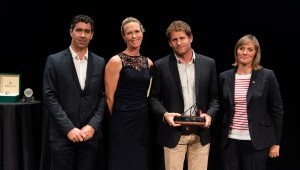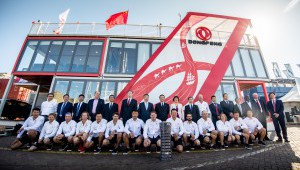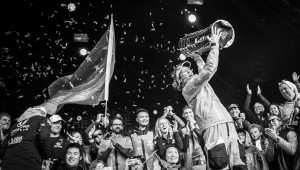Marcel, the more extreme weather of this leg looks like it is now behind the boats. Is that correct?
Yes…the really strong stuff has passed so, from now, it is going to be solid at times but it will be nothing out of the ordinary and it is all about keeping the pace on all the time.
And there looks to be breeze all the way into the final stages off Melbourne?
Yes, the high pressure is consistently forecast and is already very, very far south and I would be surprised to see it go further south and, even if it does, it will only be a temporary effect. So there is no blocking situation coming up.
From where Dongfeng is at the moment, what are the key things that Charles Caudrelier and his navigator Pascal Bidegorry need to think about as they continue to try to hold onto the lead?
The key element is probably not to panic as the breeze comes back from behind when there will be a little bit of a compression of the fleet and they need to not start doubting their speed or anything like that. This sort of thing is a fact of life in the Southern Ocean - all the new stuff, weatherwise, comes from the west which will benefit boats furthest west and furthest behind first, so that’s just what it is.
Once they have the same pressure as the guys behind, they need to be as fast or faster to pull away again because any lighter conditions will pull in from the west as well. It’s one of those elastic band situations and it is more about dealing with it psychologically than anything else. Conditions will continue to be relatively tough so it is also about keeping the speed on at all times but not making any mistakes with the ice exclusion zone which is very easily done, especially as it is so beneficial to be skirting it so closely.
Does MAPFRE – currently in a close second place - have her own options to play now?
Not really at the moment. MAPFRE and Dongfeng are so close that they are basically in the same weather system, so differentiating between the two boats is not about one of them doing something radically different or better, or taking an opportunity, because they are further north or something. No, they are basically in the same patch of water and it’s about the boat that maintains the highest average speeds. It is about everything else as well - trimming, driving and sail manoeuvres because, every time you do a manoeuvre, you lose a certain distance – so if you lose less than the other other guy then you have gained something. So there is no time to relax - it is all about keeping the pedal to the metal all the time basically.
Charles mentioned the other day in his blog from the nav station that the problem with the ice limit is that it takes away the strategy part – the options are limited along the corridor next to the limit – is that going to be the case until they get into the Great Australian Bight?
Actually it requires a micro-strategy, if you will. It’s all about timing your gybes. The routing shows a series of gybes coming up and then it’s a sort of micro-strategy to perhaps not do half of those gybes…do you wear out the crew gybing very often, or do you gybe a little bit less and not lose the distance you lose doing the gybes? So there is a little bit of that to think about. So maybe there is not so much big strategy on offer, but you have to remember on Leg 2 they had a whole open ocean to play with and they were also close together, so it is not that different this time.
It’s quite interesting that these two crews who two-boat tested for two weeks before the start off northwest Spain are now in a match race with this weather?
Yes I think they are the two boats with the most time on the water so we can see that that preparation is paying off. And it’s lucky it is because it would be a sad state of affairs if one of the other boats was leading all the time. For example Team Brunel who got their boat last – if they were consistently leading it would mean all the benefits of getting on the water early and getting your team together early and the sponsorship money early would be negated. But the differential in performance will get smaller and smaller as the race goes by. This should be the phase of the race when these two boats shine.
Where are the icebergs?
There is a group east of the Kerguelen Islands about 30 miles south of the exclusion zone. But they are small - 70 to 100 metres - and by the time the boats get there on Saturday they will be gone. In the sea temperature that is over there they won’t survive that long and there are unlikely to be any bergy bits floating further north.
The fleet is racing along the convergence zone between the warm water to the north and the cold water to the south. That was my brief to the guys before the start of the leg. I told them ‘you are never going to be cold for a very long time’ because they would be sailing along the convergence zone between the colder and warmer water. And this is why the ice is being kept at bay because it is very unlikely it will drift into the warmer water. One thing to note though is that the convergence zone is like a flood line and it is where all the rubbish in the water accumulates, so the crew has to be on their guard for fouling the keel or the rudders.
What are the prospects looking like for the finish at Melbourne – it looks relatively fast?
It’s a bit early to predict the forecast in terms of reliability. Also you know what Melbourne is like – they say that in Melbourne if you step out of the door and you don’t like the weather then go inside and step out again, it will have changed. You have the four seasons every day there because it is on the edge of an overheated sub-continental island and the Southern Ocean, so the weather just changes so quickly – it is dramatic. At the moment the pressure looks pretty good all the way into the heads at the entrance to Port Phillip Bay and then it will probably go lighter as the boats work their way up to the finish line.
So the leaders could get held up in the last miles to the finish?
Yes, I am very concerned because it is a complicated stretch of water. There is a lot of tide in the beginning. You can have three to four knots at the entrance which could be with them or against them. If it’s with them its fine; if it’s against them and there is a southwesterly, it could be pretty nasty with overfalls. If it is against them it will drop off quickly once they get inside but there are sandbanks to avoid and the winds will be more unpredictable, so it will be tricky right up to the finish line.
Thanks Marcel














